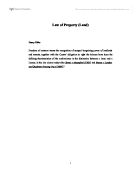Property law legal explanatory memorandum on the historical and modern day fee tail estate.
Property law legal explanatory memorandum on the historical and modern day fee tail estate.
What is a fee tail estate?
It is one of the freehold estates; the others being fee-simple and life estate. The purpose of this type of estate is the desire of landowners to keep the land in the family name or to keep power and wealth. It is conditional on the original grantee and his descendant's survival. Where the last of the grantees descendants dies it will revert back to the grantor.
It is created by the words of limitation 'heir' followed by some words of procreation. E.g. to A and the heirs of his body, or to A in tail since Conveyancing Act 1881. An estate tail may be created by will only by the same words of limitation as those required in a deed: Section 95 of the Succession Act 1965. S.95.
Owner and tenant in tail.
* a tail male/female are entails where the property descended to males or females exclusively. In order to bar the entail and create a fee simple estate, it is necessary for the tenant-in-tail to execute a disentailing deed which must be enrolled in the C.O. of the High court within 6 months of execution: Fines and recoveries Act 1833
* an entail cannot be barred by will.
* Canons of descent have been abolished except is so far as they apply the descent of an estate tail: S.11 Succession Act 1965
What is a fee tail estate?
It is one of the freehold estates; the others being fee-simple and life estate. The purpose of this type of estate is the desire of landowners to keep the land in the family name or to keep power and wealth. It is conditional on the original grantee and his descendant's survival. Where the last of the grantees descendants dies it will revert back to the grantor.
It is created by the words of limitation 'heir' followed by some words of procreation. E.g. to A and the heirs of his body, or to A in tail since Conveyancing Act 1881. An estate tail may be created by will only by the same words of limitation as those required in a deed: Section 95 of the Succession Act 1965. S.95.
Owner and tenant in tail.
* a tail male/female are entails where the property descended to males or females exclusively. In order to bar the entail and create a fee simple estate, it is necessary for the tenant-in-tail to execute a disentailing deed which must be enrolled in the C.O. of the High court within 6 months of execution: Fines and recoveries Act 1833
* an entail cannot be barred by will.
* Canons of descent have been abolished except is so far as they apply the descent of an estate tail: S.11 Succession Act 1965







